

b) Lower Member: Basin Floor (BFF)
On this member P. Vail (1989) wrote:
1) Lowstand basin floor fans are associated with the time of rapid eustatic fall, when sea level falls below the shelf break and sediments are transported across the shelf in incised valleys and rapidly dumped into the basin.
2) Lowstand fan sand lobes may develop as relatively isolated lobes or as huge accumulations of virtually basinwide extend.
3) Reservoir characteristics of these lowstand lobes depend largely on the matrix porosity and permeability of the sands and their continuity. Internally, each lobe seems to have good continuity and relatively uniform matrix characteristics, except near the lateral and downdip edges of the deposit where sediments become finer grained. However, some deposits are composed of multiple lobes, in some cases derived from different shelf edge sources, which are separated from one another by very continuous pelagic and hemipelagic shales.
4) Flow barriers can be expected in such deposits and it becomes important for reservoir development that the individual lobes be carefully described by interpretation of a combination of well and seismic data.
5) Most very large sand-lobe turbidites that form major oil and gas fields are lowstand fan systems tract sand deposits (Frigg, Halibut, Balder, Marlin, Albacora, Girassol, Plutão, Kuito, etc.). Over twenty billion oil and oil-equivalent barrels have been identified in place in these fields.
6) Seismic stratigraphic analysis, using eustatic sequence concepts is the best method of searching for these reservoirs. As exploration moves into deep marine waters, these deposits are among the most promising targets. Many undrilled examples are known of in the industry.
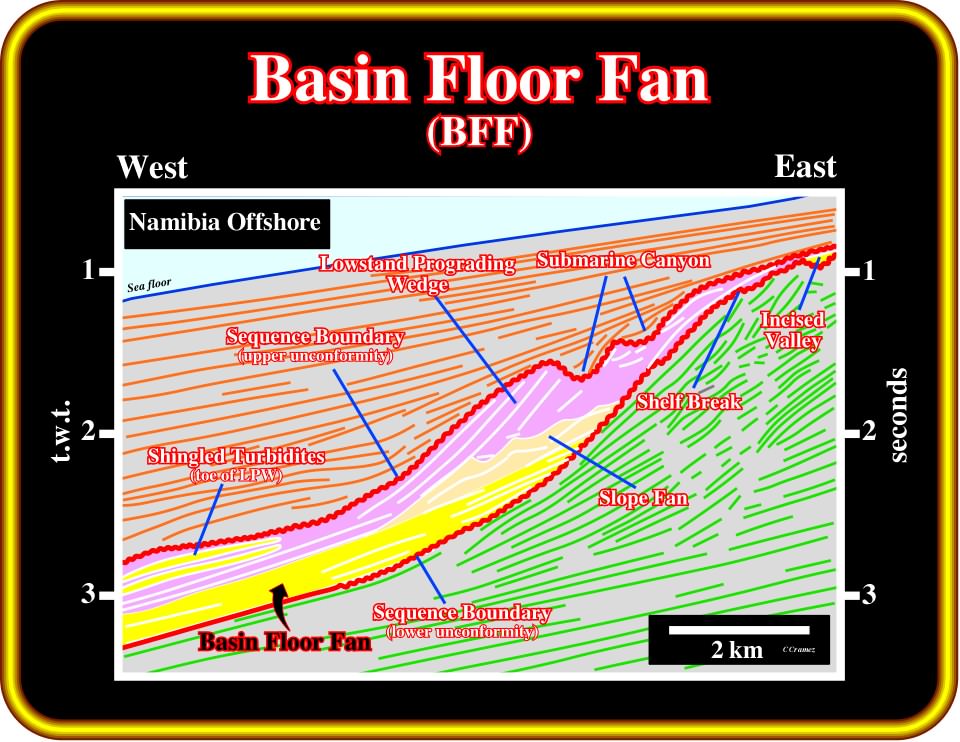
Plate 374- On this detail of a tentative interpretation of an offshore Namibia seismic line (see also Plate 388), the three members of a lowstand systems tract are easily recognized between the unconformities bounding an incomplete sequence cycle. From bottom to top, it is quite easy to identify (i) the basin floor fan (BFF), in yellow, (ii) the slope fan (SF), in light brown and (iii) the lowstand prograding wedge (LPW), in violet. Submarine canyons (SC) and incised valleys fills (IVF) are pinpoint on the upper and lower sequence boundaries. Shingled turbidites are identified on the toe of progradation of the lowstand prograding wedge. On the Plates, the main characteristics of basin floor fans will be reviewed.
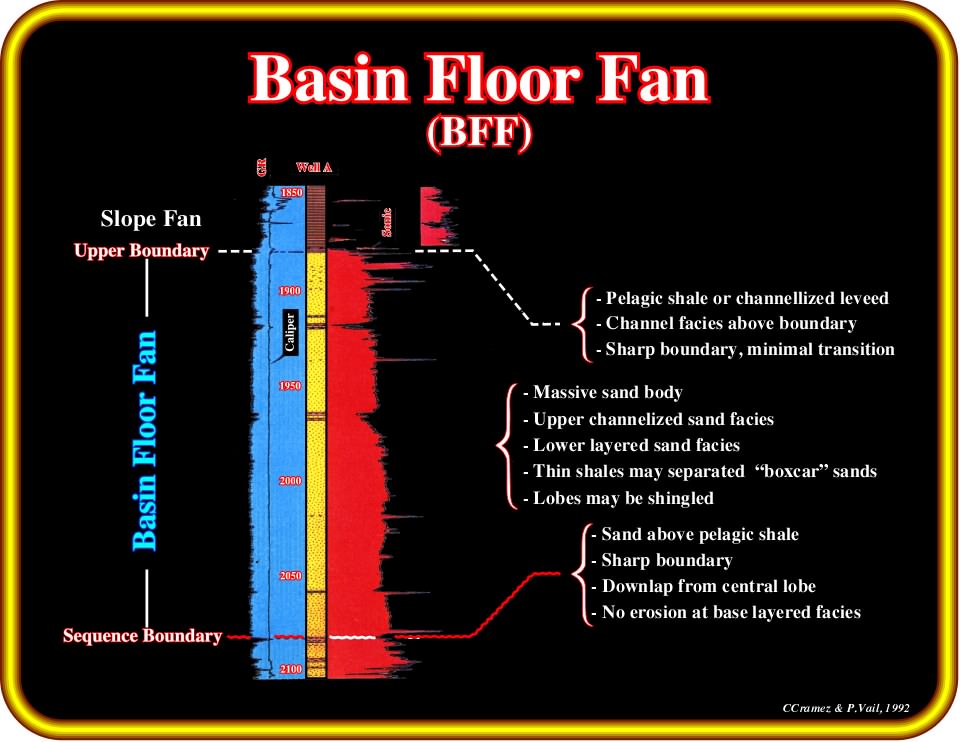
Plate 375 - As illustrated on this electrical logs (North Sea well), basin floor fans (BFF) have characteristic log patterns with sharp boundaries and thin shale horizons separating massif box sand lobes. The lower limit corresponds to a sequence boundary, while the upper limit corresponds, quite often, to a sharp transition to channel levee complexes of slope fans.

Plate 376- This tentative interpretation of regional seismic line, from the North Sea, shows the geological context and morphology of the unconformity between the Mesozoic rift-type basin and the overlying Meso-Cenozoic cratonic basin. The sharp break in the dip of this unconformity, recognized on the right part of the line, corresponds to the limit between the abyssal plain and slope environments, where sand bodies with the characteristics of basin floor and slope fans are easily identified, as shown on the close-ups illustrated on the next plates.
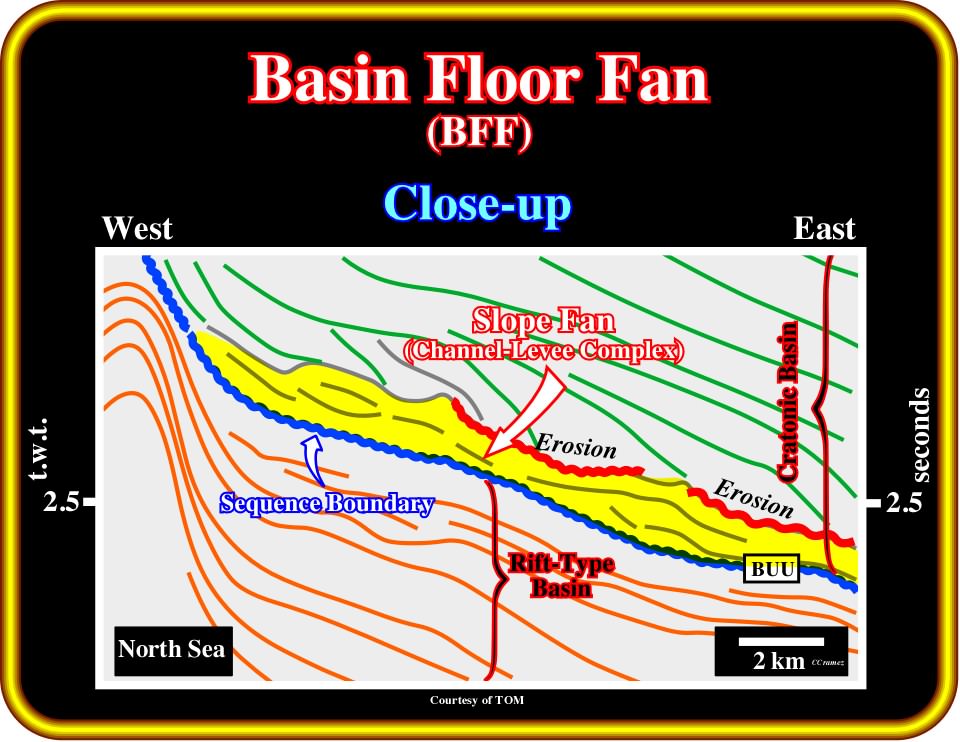
Plate 377 - On the landward close-up, pinpointed on the previous tentative interpretation (Plate 376), the eastward dip of the unconformity between the Mesozoic rift-type basin and the overlying Meso-Cenozoic cratonic basin (North Sea basin) strongly suggests the basal sediments of the cratonic basin, in these areas of the basin, were deposited in a continental slope environment. Besides, the morphology and internal configuration of these basal stratigraphic intervals hint that they correspond to slope fans. In fact, as we will see later, the hummocky, or undulated internal configuration recognized above, is often associated with channel-levee complexes of the lowstand systems tracts (slope fan).
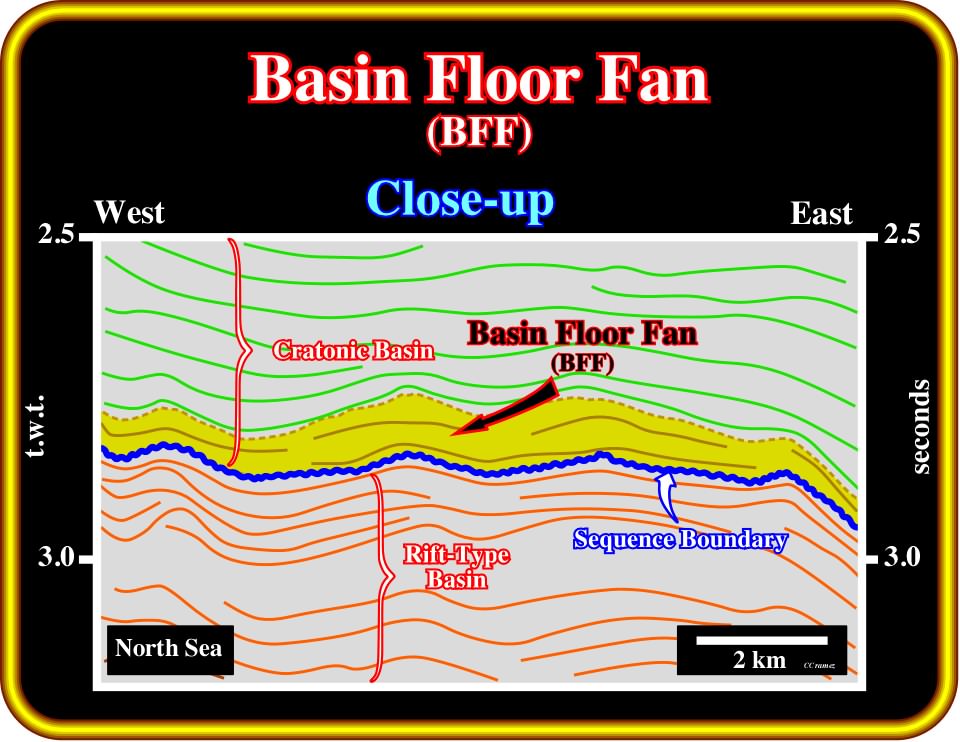
Plate 378- On this close-up (see Plate 376), located eastward of the one in which channel-levee complexes of a slope fan are likely, the geometry of the unconformity, between the Mesozoic rift-type basin and the overlying Meso-Cenozoic cratonic basin, suggests an abyssal depositional environment for the basal cratonic sediments. The basal massif sandprone body, deposited above the unconformity, has the characteristics of a basin floor fan. Actually, not only the depositional environment, but the lobate geometry (recognized on seismic maps) and internal configuration (parallel or reflection free) corroborate a basin floor fan interpretation.
Exploration Applications:
1) Reservoir :
- Typically excellent k &
(permeability & porosity) ;
- Continuity variable, often a problem in upper channelized lobes.2) Migration :
- Vertical from deeper sources ;
- Possible downward and lateral from condensed section shales :3) Source :
- Leakage from deeper beds ;
- Possible top and condensed section shales.4) Trap :
- Typically non structural (morphological).
5) Seal :
- Excellent, pelagic shale of condensed section.
- Risk no seal if overlain by slope fan.
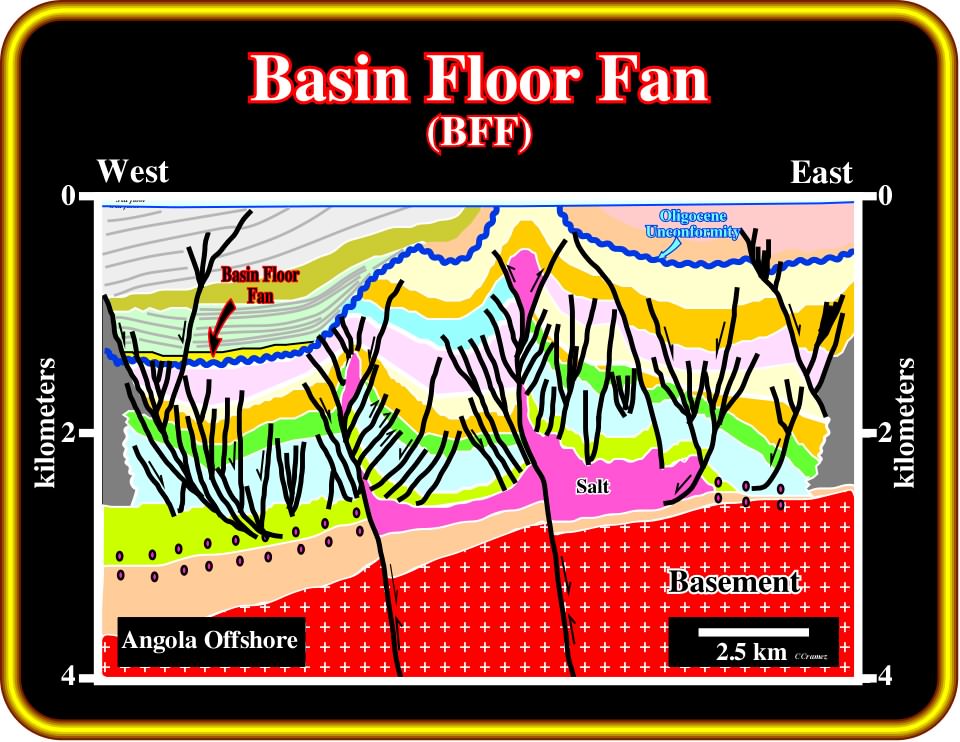
Plate 379 - This tentative interpretation of a seismic line comes of the conventional offshore of Angola (Kwanza basin, around 20 km of the capital Luanda), where several exploration wells have found, below the tectonically enhanced Oligocene unconformity (in blue on the interpretation), significant accumulations of relatively heavy oil (14-16 API). In spite of that, no wells have targeted the potential basin floor fan reservoirs deposited on the Oligocene unconformity, which are nicely illustrated on this line. Such basin floor fans should be quite rich in sandstone reservoirs. They are located seaward of the old position of the Kwanza river mouth (S. Tiago beach, northward of Luanda), which, presently, is around 100 km south of Luanda (Barra do Kwanza).

Plate 380 - This tentative interpretation of an offshore Orinoco (Eastern Venezuela) seismic line illustrates the proximal area of the Atlantic-type divergent margin, where structural traps are absent. In spite of that, PDVSA (the national oil company) suggested the presence of turbidite lobes, probably basin floor fans, with which high-class morphological traps are often associated. Theoretically, during the post-Pangea regressive or foresteeping (progradational) stratigraphic phase, relative sea level falls with significant seaward displacement of the coastal onlap may have exhumed the shelf and created geological conditions favorable for lowstand deposits, particularly turbidite depositional systems (slope and basin floor fans). So, on this line, the sedimentary anomalies lying on the red colored unconformity, can be considered as seaward tilted basin floor fans, that is to say, potential hydrocarbon targets
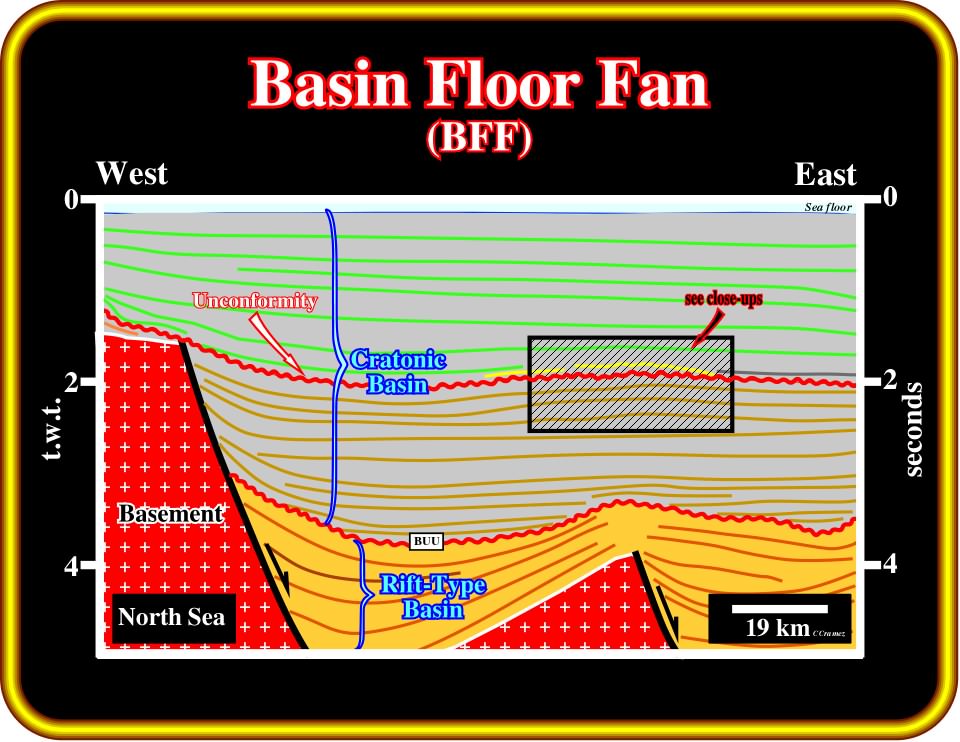
Plate 381 - In the North Sea, and particularly in the Meso-Cenozoic cratonic North Sea basin, where structural traps, that is to say, traps with four way dip closure, are practical no existent, lowstand turbidite deposits, and associated morphological traps, are excellent alternative hydrocarbon targets. In spite of the fact that the initial Frigg field reservoirs were considered as deltaic (the majority of the fauna is transported from shelf environments), a turbiditic origin and a deep water depositional environment became a paramount interpretation. Due to the restricted cratonic geological conditions, one cannot consider the North Sea basin floor fans as a archetype particularly for the deep lowstand deposits of Atlantic-type divergent margins. As illustrated on the next close-ups of this tentative interpretation, local deep-water erosion and subsequent deposition can entangle the original depositional geometry.
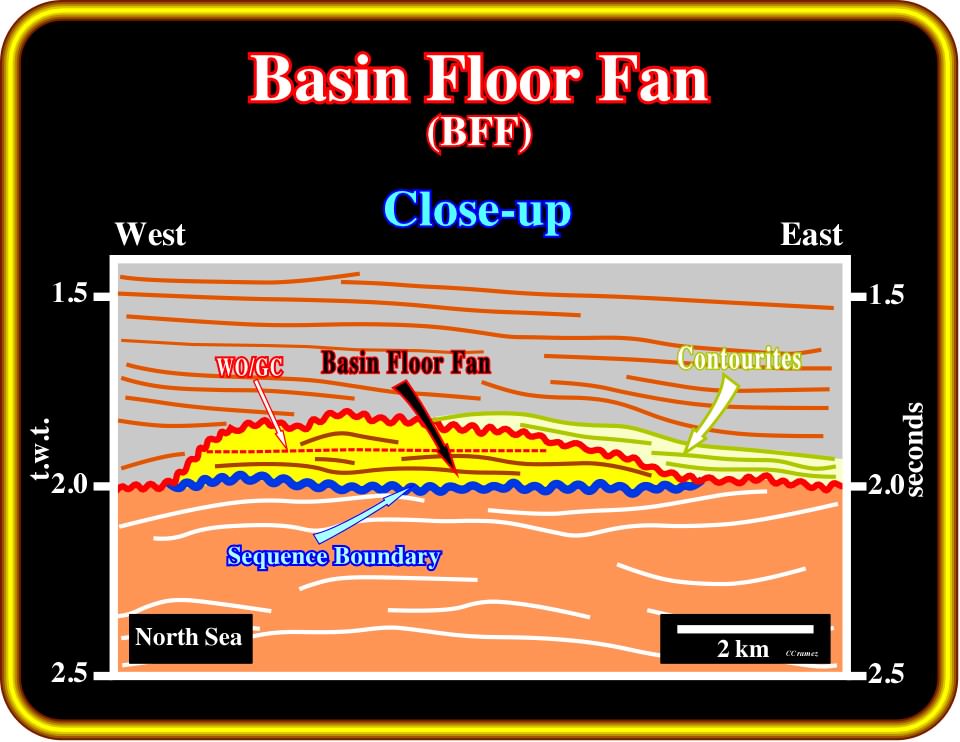
Plate 382 - On this close-up of a North Sea basin floor fan (see Plate 381), it is easy to realize that the pristine mounded morphology of the basin floor fan, deposited above the sequence cycle boundary (colored in blue), was altered by meaningful deepwater erosion. It looks like that the eroded sediments were immediately deposited above the local deepwater erosional surface (colored in white). Actually, the sandbodies overlying the basin floor fan, which are colored in yellow and known as contourites, are interpreted as the redeposited sands formerly eroded from the basin floor fan. These sandbodies are readily differentiated from those of the basin floor fan. As illustrated on the next close-up, they have a progradational geometry, which strongly contracts with the aggradational geometry of the basin floor fans. The horizontal reflector, visible within in the basin floor fan, is a diachronous reflection that corresponds to the oil/water or gas/water plane.
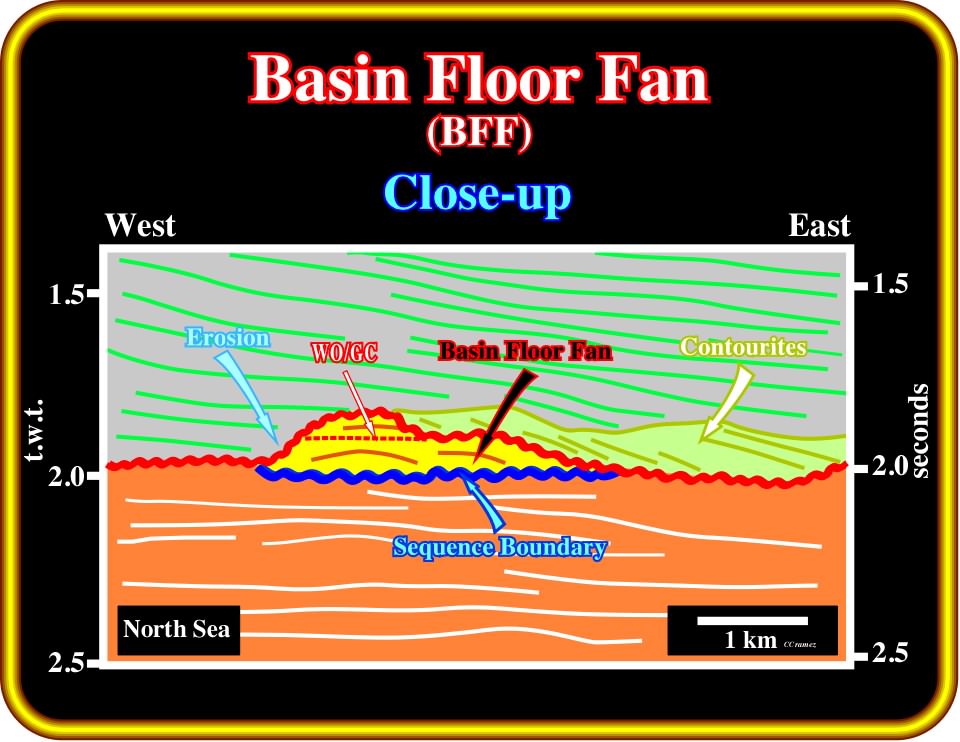
Plate 383 - On this close-up (see Plate 402), the progradational geometry of the contourites is quite obvious. Such geometry contrasts with the aggradational geometry of the basin floor fan. These different geometries have been confirmed by dipmeter log results of the development wells, which indicate a 10º-15º regional dip (N 70º-100º azimuth) for the contourites and roughly zero for the basin floor fan. The term contourite proposed by E. Mutti is confusing. Actually, in the 60's, Bouma proposed this term to label, in the Swiss flysch, heavy mineral rich channel fills, which were supposed to be filled by turbidite sediments transported perpendicularly to the trend of the channels, which Bouma interpreted as erosional submarine valleys, or channels, created by contour currents.
Exercises:
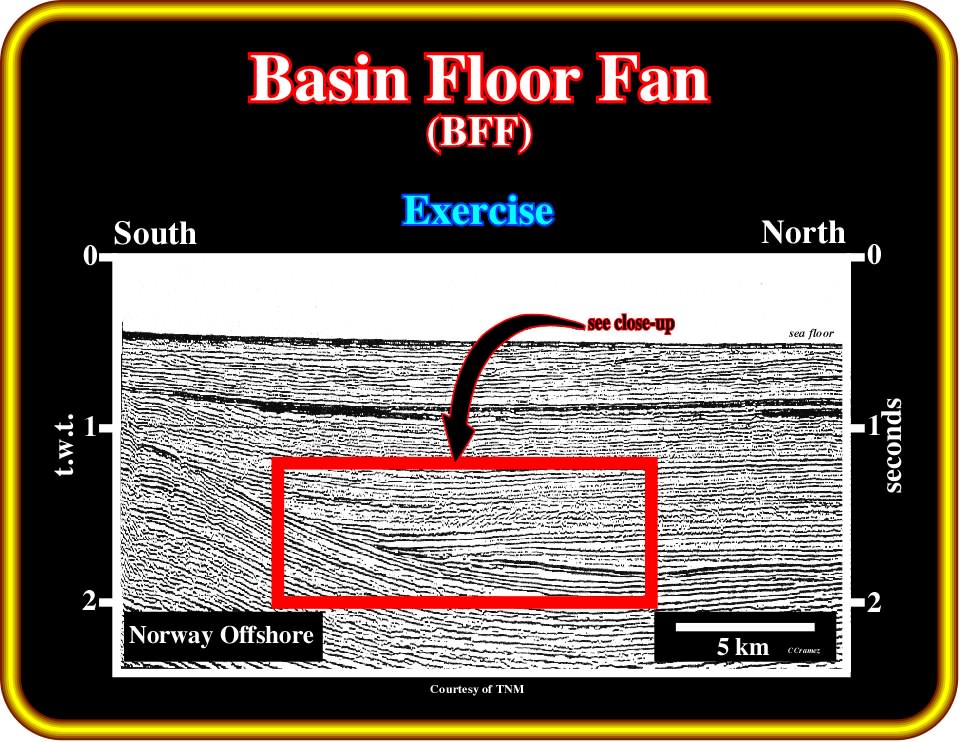
Plate 384 - As an exercise, consider this seismic line from the offshore North Finmark West, i.e., a seismic line shot in the offshore of an Atlantic-type divergent margin developed above a Paleozoic substratum. Taking into account that a mobile layer, i.e., a thick evaporitic stratigraphic layer exists in this margin, try to recognize the reflection terminations and the seismic surfaces within the red rectangle and pick the clearest unconformity . On the next Plate, where you will find a close-up of this line.
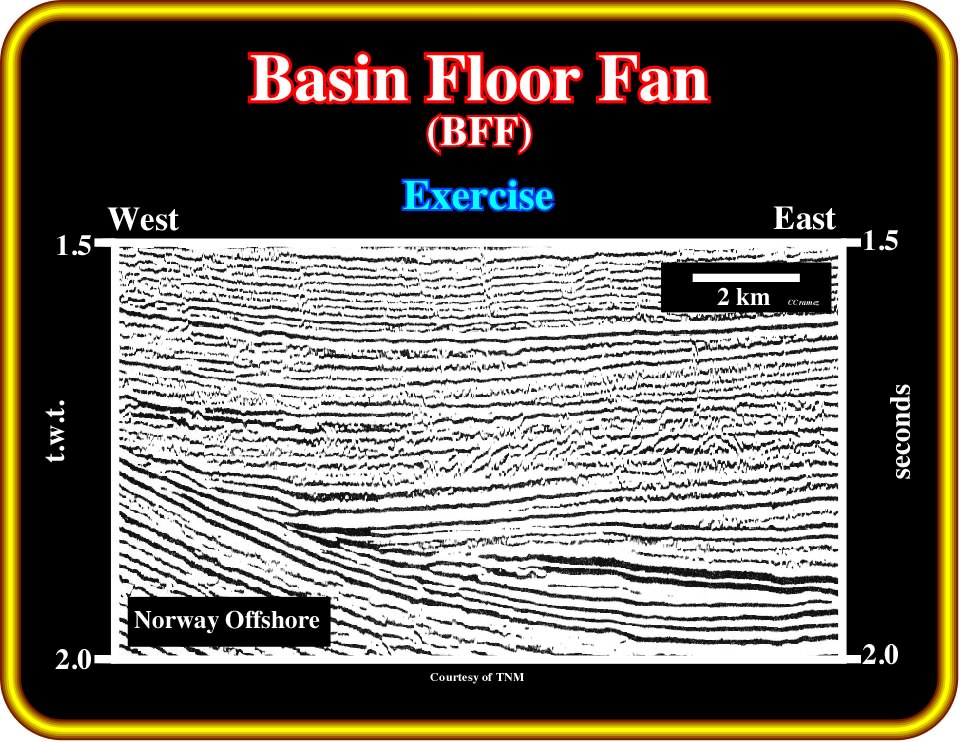
Plate 385 - One or several lowstand systems tracts can be recognized on this close-up of the line illustrated on Plate 405. After picking the more evident unconformity, which is underlined by an evident onlap seismic surface, propose a sequential interpretation of the overlying seismic intervals. Then, assuming the presence of deep generating petroleum subsystem, propose the best location for a wildcat. Explain the location of such a well and make a prediction of the more likely lithology of the sedimentary interval recognized by the well. Finally, propose the more likely log pattern response (Gamma ray or SP).
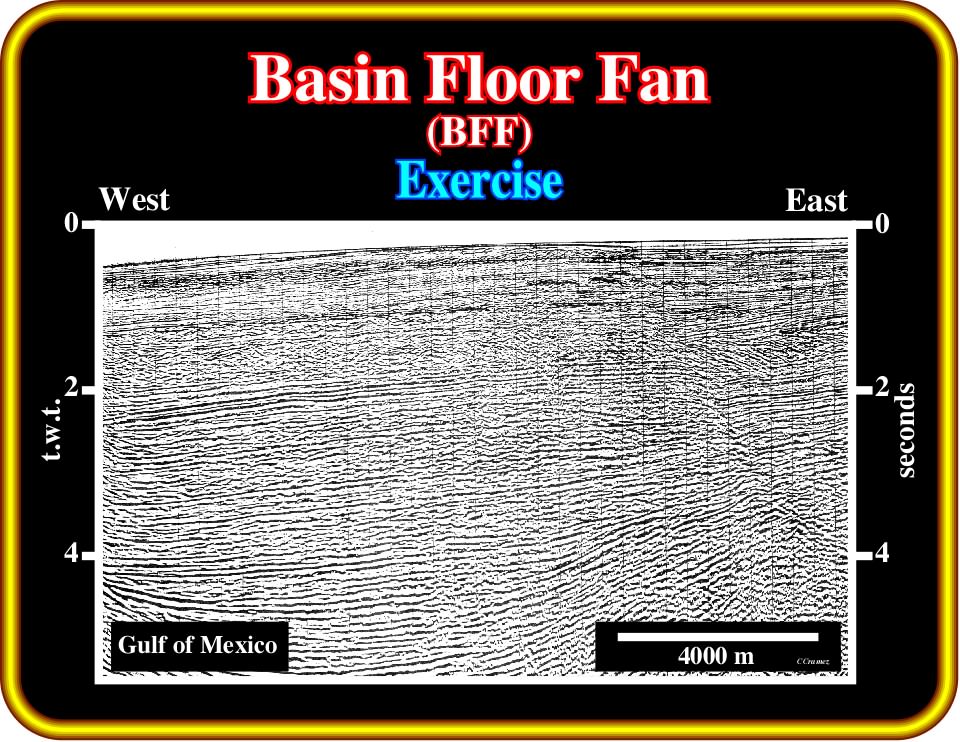
Plate 386 - On this line from the Gulf of Mexico, start to recognize the more evident unconformity, which is underlined by an obvious onlap seismic surface located roughly at 4 seconds (t.w.t.). Then, make a sequential interpretation of the overlying seismic packages, taking into account the different reflection terminations. Then, using systems tract analysis, propose the more likely facies (lithology) of the depositional systems composing the different systems tracts giving particular attention to the potential hydrocarbon reservoirs. Finally, assuming the presence of a deep generating petroleum subsystem, that is to say, the presence of deep source rocks (mature organic matter) propose two exploration wells and explain trapping mechanism and reservoir geometry for both.